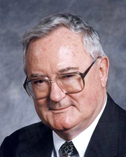

Orville L. Chapman
University of California, Los Angeles
June 26, 1932 - January 22, 2004
|
Scientific Discipline: Chemistry Membership Type:
Member
(elected 1974)
|
Orville Chapman was a pioneer in photochemistry, matrix isolation spectroscopy, reaction intermediates, chemical communication, the mechanism of olfactory perception, and polymeric materials. Especially well known for his work in organic photochemistry, Chapman left a major mark as well on materials design—notably carbon allotropes, wherein his insights preceded the discoveries of fullerenes, buckytubes, and graphene. As a long-term consultant for Mobil Chemical, he participated in the development of many of the company’s industrial processes. Chapman devoted his energies not only to scientific invention and discovery but also to conceiving and bringing into practice new modes of education; for example, he gained a worldwide reputation for bringing the best of information technology to academia.
Chapman was born in New London, Connecticut, but spent his childhood in Panama (as his father, a U.S. Navy seaman, was stationed in the Panama Canal Zone), Washington, DC, San Diego, CA, and Norfolk, VA, where he graduated from high school in 1950. Chapman then attended Virginia Polytechnic Institute, graduating in 1954 with a double major in chemistry and English. (He thus had his start in chemistry while also gaining a lifelong love for prose and poetry.) He continued his study of chemistry in the graduate program of Cornell University and in 1957 received his Ph.D., which established his enduring interest in organic synthesis; Chapman’s thesis specifically involved the synthesis of tropolones and rearrangement reactions of related molecules.
After completing his doctorate, Chapman accepted a faculty position at Iowa State University, where he quickly moved through the professorial ranks while doing innovative studies in the emerging field of organic photochemistry. He moved to the University of California, Los Angeles, in 1974, and entered a long and productive period involving, for example, his investigation of a wide variety of organic reactive intermediates (such as carbenes, nitrenes, propadienones, silenes, carbonyl oxides, and strained alkynes) and his program on the synthesis and study of insect sex pheromones.
In 1984, Chapman began to devote his energies and intellect to education; he served as UCLA’s associate dean for educational innovation for 10 years, during which his accomplishments included the UCLA Science Challenge—a case-study-based approach to revamping lower-division science education using technology. This work received the 1995 ComputerWorld Smithsonian Institute Award for the best use of computers in education and academia. In 2004, the undergraduate computer center at UCLA was dedicated in his honor. The Orville L. Chapman Learning Center now stands as a testament to the life and achievements of this creative scientist and educator.

